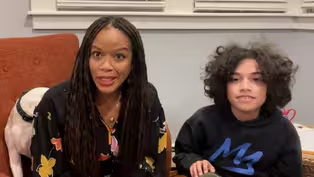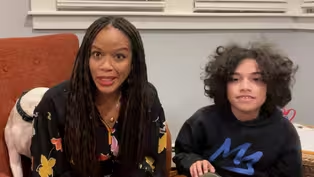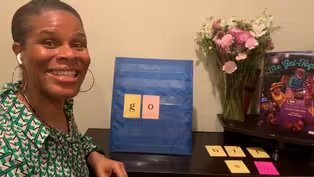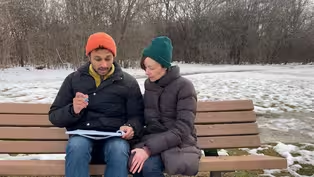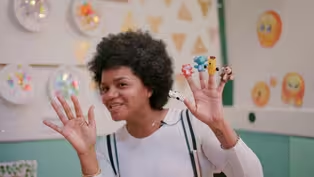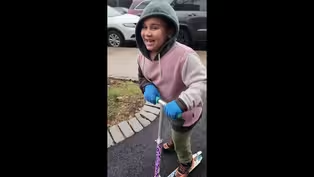
HOW ANIMALS MOVE
Clip: 5/19/2023 | 9m 20sVideo has Audio Description, Closed Captions
Devon Ritter from the Memphis Zoo explores how animals run, slither, fly, and hop to move.
Devon Ritter from the Memphis Zoo explores how animals move by running, slithering, flying, and hopping.
See all videos with Audio DescriptionADProblems playing video? | Closed Captioning Feedback
Problems playing video? | Closed Captioning Feedback
Let's Learn is a local public television program presented by THIRTEEN PBS

HOW ANIMALS MOVE
Clip: 5/19/2023 | 9m 20sVideo has Audio Description, Closed Captions
Devon Ritter from the Memphis Zoo explores how animals move by running, slithering, flying, and hopping.
See all videos with Audio DescriptionADProblems playing video? | Closed Captioning Feedback
How to Watch Let's Learn
Let's Learn is available to stream on pbs.org and the free PBS App, available on iPhone, Apple TV, Android TV, Android smartphones, Amazon Fire TV, Amazon Fire Tablet, Roku, Samsung Smart TV, and Vizio.
Providing Support for PBS.org
Learn Moreabout PBS online sponsorship[upbeat music] - Hi everyone and welcome to the Memphis Zoo here in Memphis, Tennessee.
My name is Devon and I'm an animal interpreter here at the zoo.
That means I have the very special job of getting to take care of some of the zoo's animals and introducing them to people just like you.
And today, we're learning all about transportation.
Transportation is the way that animals and people move around.
Think of the last time you went to the store or to the park or to visit a relative.
How did you get there?
Humans get around in many ways.
We can walk, run, drive, take a bus, use a wheelchair, ride a bicycle, jump on a pogo stick and even fly in an airplane.
Animals are also great at getting from place to place.
Today, we will explore the zoo and meet some animal friends that will teach us how they move.
Let's meet some animals and see how they run, slither crawl, hop, swim and fly.
Say hello to the fastest land animal on the planet, the cheetahs.
Cheetahs have to be able to run incredibly fast in order to catch their prey.
Cheetahs use their long legs to run through the plains of Africa.
Cheetahs usually hunt during the daytime in order to avoid competing with other predators like lions and hyenas.
While cheetahs are the fastest land animals they can't keep that speed up for very long, and in fact most cheetah chases last under a minute.
Do you think that you could outrun a cheetah?
Let's see how fast you can go.
Ready, on your mark, get set, go!
Wow that was really fast.
Many land animals have to be able to run in order to survive.
Animals that eat meat need to be able to chase their prey and prey animals have to be able to outrun the predators.
As predators get faster, so does the prey.
If predators were always faster, they would eat all the prey until there were no more and eventually they would run out of food.
But if the prey were always faster, there wouldn't be any food for the predators to eat.
This is how the food web stays balanced.
So running is great and all, but what if you don't have any legs?
This is Dan and Dan is a legless lizard.
Did he fool you into thinking that he was a snake?
That happens all the time.
Many people believe that lizards have legs and snakes have no legs, but that's not quite the truth.
There are some lizards just like Dan here, who have no legs at all.
There's a couple of other key differences that I use to tell whether or not Dan is a snake or a lizard.
I can tell that Dan is a lizard by looking closely at his ears and his eyes.
Snakes don't have eyelids or ear holes, and Dan has both.
Legless lizards are sometimes called glass lizards.
That's because unlike snakes, their tails are very fragile and can break off as handled improperly or if they're attacked by a predator.
Legless lizards are excellent neighbors to have around because of how good they are at pest control.
Many small animals are good at slithering.
Legless animals like snakes, worms or slugs can track their muscles to move forward when they slither.
It allows them to get into small places like burrows to find shelter.
But slithering animals don't just live on the ground.
Many are excellent climbers simply found in trees or even on the sides of buildings.
So we learned that many animals without legs can slither like our friend Dan.
But what about some of our animal friends that have lots of legs?
This is Buddy and Buddy is a Madagascar hissing cockroach.
Now Madagascar hissing cockroaches like Buddy can be very popular in movies and TV shows, and that's because they're very large and easy to film and they're pretty easy to work with.
Unlike many other species of insects, Madagascar hissing cockroaches can't fly, so their major means of transportation is on their six legs.
And yes, I did say six.
Buddy here is excellent at crawling around and looking for food.
In the wild, Cockroaches have an important job to do.
They're like the cleanup crew of the forest.
They eat many of the rotten foods that other animals won't eat.
They eat decaying leaves, fruits and veggies and even meat.
Now imagine the trash can in your house.
When it's full, what happens to it?
Usually someone takes it out and the garbage collectors take it away.
But what if they didn't?
What if all the garbage in the world just piled higher and higher and no one was able to clean it?
That's what a world without cockroaches would seem like.
Cockroaches are exceptionally good crawlers.
They can even climb straight up walls.
That's because their legs have tiny claw like feet that help them to climb.
Many insects crawl, but other animals can crawl too.
Reptiles like alligators, lizards and turtles all have legs very close to the ground and are built for crawling.
Invertebrates like scorpions, tarantulas and crabs are also excellent crawlers and can be quite speedy.
Even mammals like the sloth can slowly crawl when they come to the ground.
Can you crawl on the ground like a lizard or a sloth?
All right, friends, are you ready to move again?
Let's see if you can hop.
How high can you jump?
Well, this here is my friend Charming.
And Charming is a smooth-sided toad.
Unlike his froggy relatives, he may not be the highest jumper in the world, but he does hop around his enclosure and he really enjoys chasing after his favorite food, cricket.
Can you think of any other animals that can hop?
My friends, you may be wondering why am I using gloves to hold Charming?
Is it because he's dangerous?
Well, actually it's because my skin can be really harmful to him.
Toads actually will breed and drink through their skin, so it's really important that we aren't touching them with any chemicals.
And I could be wearing lotion or hand sanitizer that could be really harmful for him.
So the gloves are here for his safety.
Animals that hop usually have very long legs.
Rabbits, kangaroos, frogs, insects, and many more animals use hopping as a way to move from place to place.
You may be surprised to hear that hippos hop too.
They're too heavy to swim, so instead they hop along the bottom of the rivers and come up for air.
Speaking of swimming, that's my favorite way to move.
But even I don't love the swim as much as our friends, the sea lions.
Sea lions start swimming just three weeks after they're born.
Sea lions are mammals just like humans, but unlike us, they're specially adapted for the water.
Instead of having hands and feet, they actually have flippers.
It's a lot like having oars or paddles for hands.
Sea lions rely on swimming in order to hunt their favorite food, fish.
As we all know, fish are incredible swimmers, so the sea lions have to be just as good.
Water covers most of the earth, so knowing how to swim is a must for many types of animals.
All fish and many birds, mammals and amphibians and even reptiles have adapted to swim.
Some animals like the sea lions, spend most of their lives in the water, while others like fish can never leave it.
Water is an important source of food for many animals so many species have learned to swim.
Tigers, otters, penguins and polar bears are all excellent swimmers and some animals like humans enjoy swimming just for fun.
Now many of us have been able to move like our animals friends so far, but the next animal can do something that no human can do, at least not without a little bit of help.
Can you guess who it is?
Meet Adelaide, the kookaburra.
Kookaburras, like many other birds are excellent flyers.
It's not just birds that can fly bats and insects can do it too.
Flying may look different between the species, but it involves flapping their wings.
Birds have feathery wings.
Bats have a thin layer of skin between their long finger bone and insect wings are a part of their exoskeleton.
All of these species have had to go through many changes in order to achieve flight.
Flying is a great way for animals to move from place to place.
Many animals that fly become an important pollinator, helping plants to grow all over the world.
That's because some places like islands are very hard to reach unless you can fly.
Humans can also fly, but only with the help of technology like airplanes and helicopters.
If you could fly like a bat or a bird, where would you go?
I would love to fly to a tropical island.
Today we learned about a few of the amazing ways that animals use to move around.
Can you remember them all?
Today we ran like the cheetahs.
We slithered like a legless lizard.
We crawled like a cockroach.
We flew like a kookaburra.
We swam like the sea lions and we hopped like the toads.
These were just a few of the many ways that animals move themselves from one place to another.
We also learned that animals use special body parts to help them move like wings for flying, fins or flippers for swimming or long legs for running and jumping.
Isn't it amazing how animals move in so many different ways?
What's your favorite way to move?
I hope you all had just as much fun as I did today learning all about animal transportation, but now it's time for me to ride off into the sunset.
From me and all of us here at the Memphis Zoo, have a great rest of your day everyone.
Video has Audio Description, Closed Captions
Clip: 6/12/2023 | 9m 36s | Maria Begg-Roberson reads THE LITTLE CAR by Xu Han. (9m 36s)
Video has Audio Description, Closed Captions
Clip: 5/19/2023 | 9m 36s | Maria Begg-Roberson reads THE LITTLE CAR by Xu Han. (9m 36s)
Video has Audio Description, Closed Captions
Clip: 5/19/2023 | 10m 22s | Isabel Simmons explores how to blend, read, and write words with long o and ow. (10m 22s)
Video has Audio Description, Closed Captions
Clip: 5/19/2023 | 7m 42s | Omar Etman takes a bike ride and makes a map of his journey. He shares with Lily Fincher. (7m 42s)
Video has Audio Description, Closed Captions
Clip: 5/19/2023 | 11m 24s | Diane Sanlatte teaches a version of the song “No More Monkeys” in Spanish. (11m 24s)
Video has Audio Description, Closed Captions
Clip: 5/19/2023 | 6m 13s | Cheyney McKnight from the New-York Historical Society explores the suffragist movement. (6m 13s)
TIBERIUS SHOWS HOW TO RIDE A SCOOTER!
Video has Audio Description, Closed Captions
Clip: 5/19/2023 | 28s | Tiberius shows how to ride a scooter. (28s)
Providing Support for PBS.org
Learn Moreabout PBS online sponsorshipSupport for PBS provided by:
Let's Learn is a local public television program presented by THIRTEEN PBS
